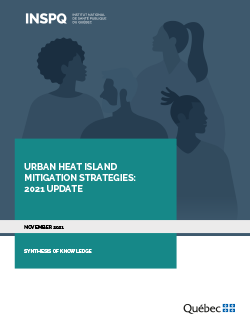Urban Heat Island Mitigation Strategies: 2021 Update
- This literature review covers measures to mitigate urban heat islands that decision-makers and public and private property managers, municipal stakeholders, non-profit organizations, and other project designers can implement in Québec to ensure healthy, comfortable living environments.
- Urban spread, the loss of crown cover, soil sealing, the use of heat-retaining materials, heat and greenhouse gas emissions stemming from human activities, and urban morphology with dense neighbourhoods and narrow streets are causal factors in urban heat islands. Rising temperatures and more frequent heat waves against a backdrop of climate change are likely to exacerbate their impact.
- Urban heat islands can have detrimental environmental impacts such as the deterioration of air quality and adversely affect human health and well-being. Certain factors for increased vulnerability to heat such as age and chronic diseases warrant paying particular attention to certain populations when adaptation measures are implemented. Urban heat islands, which are often situated in underprivileged neighbourhoods, are also contributing to social inequalities in health.
- Permeable materials facilitate district cooling by fostering water infiltration in the soil and evaporation, whereas high-albedo materials promote the cooling of cities by preventing the absorption of solar radiation.
- Greening measures engender high cooling gains in urban settings. When vegetation is used on the roofs or walls of buildings, it improves their insulation by keeping them cool in the summer and limiting heat loss in the winter. However, climate change is affecting plants (heat, insects). It is, therefore, important to plant more trees but also to carefully choose them to limit deleterious impacts on health and the risk of canopy loss stemming from different meteorological hazards.
- Existing and new buildings must be adapted to climate change. Recourse to air conditioning alone must not be considered to cool homes. Complementary solutions must be explored. Challenges that urban heat poses are to be considered in building architecture, e.g., bioclimatic architecture, and in urban planning, e.g., urban morphology.
- Blue spaces such as lakes and ponds can alternately act as a source of heat or cooling in urban environments. Such spaces with large areas are usually more effective from the standpoint of cooling, as is circulating water in rivers or when technologies based on water evaporation such as fountains are used. Reliance on green infrastructure in stormwater management engenders numerous benefits, including the mitigation of urban heat islands, resilience to flooding, and improved water quality.
- In addition to enhancing thermal comfort conditions, the implementation of measures to address urban heat islands engenders numerous human mental and physical health benefits and prevents heat-related morbidity and mortality.
- The combination of several large-scale measures is necessary and helps to reduce heat in cities. Community involvement in projects to mitigate urban heat islands guarantees success, as reported both in the literature and in case studies.


